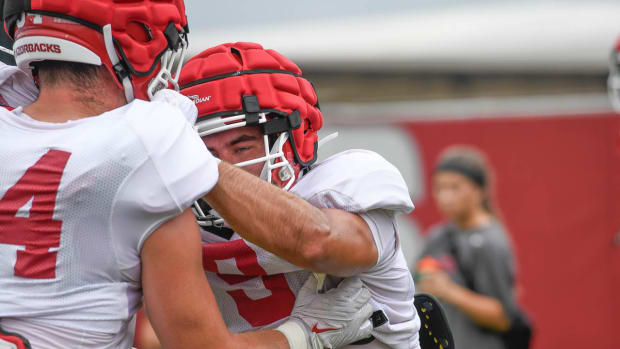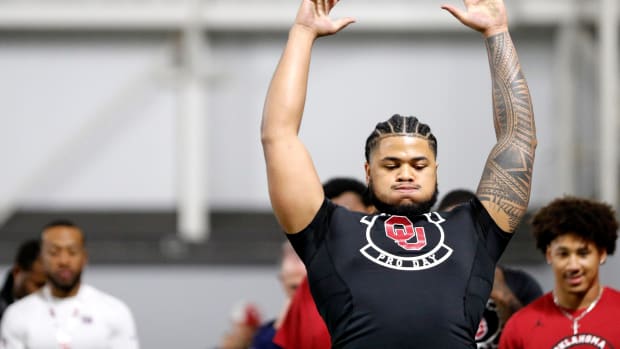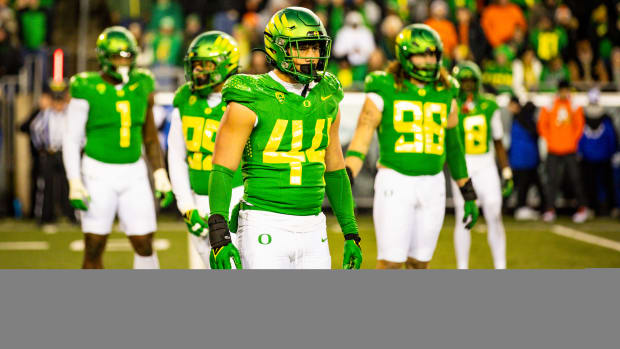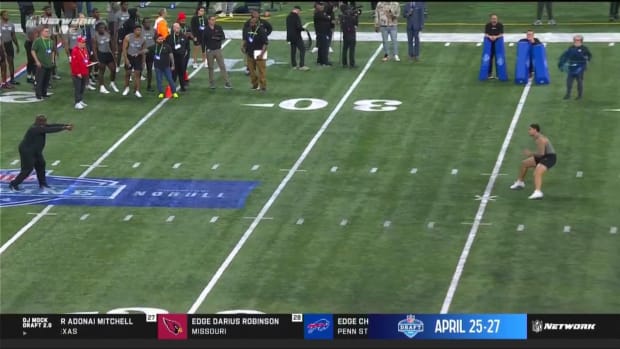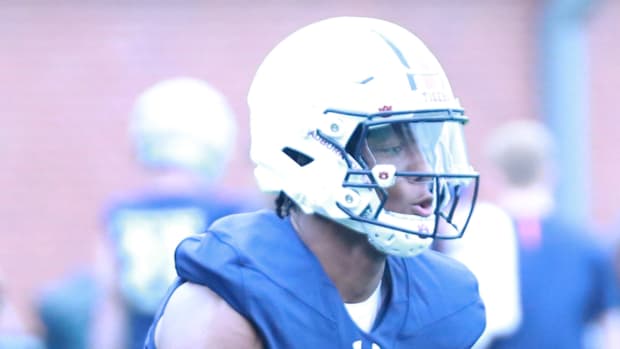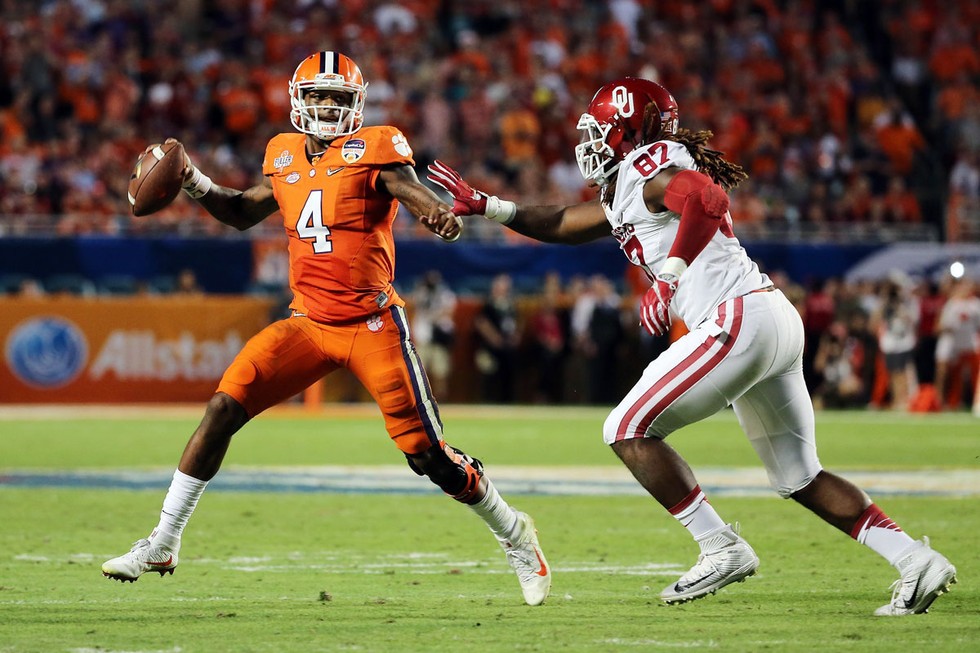
Are college quarterbacks who play in spread offenses hurting their draft stock? The answer isn't so simple
[video: 13724898]
This is Part II of an eight-part series on the recruiting, development and evolution of quarterbacks. The next installment will be Friday with Lindsay Schnell's podcast with renowned QB guru Trent Dilfer.
Marcus Mariota authored one of the greatest college football careers in recent memory. Over three seasons as Oregon's starting quarterback, he led the Ducks to 36 wins and an appearance in the inaugural College Football Playoff national championship game, claimed the first Heisman Trophy in program history and repeatedly foiled the best-laid plans of defensive coordinators across the Pac-12. By the time he left college in 2015, Mariota had, by almost any objective measure, proven himself as a premier player at his position, a dual-threat dynamo with the potential to alter the trajectory of whichever franchise he joined.
Yet in the months leading up to the draft, Mariota faced questions over his viability as a pro passer. The main gripe—from the perspective of TV analyst X, anonymous scout Y and a parade of others weighing in on that year's collection of quarterbacks—was that Mariota may have difficulty transitioning to the NFL because of his history playing in Oregon's spread offense as opposed to a pro-style attack. The criticism didn't just obscure Mariota's illustrious college track record, but the top-line speed and improvisational playmaking that made him such a highly regarded prospect.
All of it must have felt like a wake-up call for the growing number of college coaches who hope to attract elite high school quarterbacks to run their spread offenses. In doubting Mariota's NFL potential, draft experts were arguing that even a generational talent was flawed by dint of his lack of experience in a pro-style system. At the same time, the doubt surrounding Mariota likely provided ammunition for coaches looking to recruit top-flight high school passers to run their pro-style systems. Our offense will prepare you for the NFL, some coaches might say.
When courting four and five-star prospects around the country at any position, coaches will use every resource at their disposal. Scheme can be deployed as a selling point or an incentive to stay away from a rival school. Yet the pro-style/spread binary that pervades analysis at the college level and in the pre-draft process should no longer hold much weight as a recruiting tool. As prep quarterbacks weigh which school to attend, "scheme fit" feels increasingly like a distortion of reality that benefits some schools at the expense of others.
Mariota was not the first high-profile quarterback whose viability as an NFL quarterback was challenged because of his college offense. Coaches, scouts and analysts have not hesitated to point out—or, at the very least, imply—that the spread can inhibit passers' adjustment to the pros. At last year's NFL Combine, Arizona Cardinals coach Bruce Arians said, "So many times, you're evaluating a quarterback who has never called a play in the huddle, never used a snap count. They hold up a card on the sideline, he kicks his foot and throws the ball. That ain't playing quarterback. There's no leadership involved there."
Last September, a Wall Street Journal article quoted multiple coaches and executives who expressed concern over college quarterbacks' difficulty digesting NFL offenses. Buffalo Bills general manager Doug Whaley told author Kevin Clark that he was "a little nervous about the long-term future of this game." Go back a few years, and NFL types communicated a similar message. Former Baltimore Ravens coach and current NFL Network analyst Brian Billick wrote in April 2012 that "The spread gun offenses are an effective use of the talents available to the college game, but little of the attributes that it takes to run this type of system translates into the NFL."
For many college coaches, the belief, however valid, that quarterbacks developed in spread offenses cannot cut it in the NFL presents a serious problem on the recruiting trail. While top QB recruits take a number of factors into account when choosing a given school—location, the depth chart and relationships with position and head coaches—the NFL is often a serious consideration. This makes plenty of sense: These prospects want to win lots of games and put up big numbers in college, yes, but they also want to know that the coaches leading their prospective program will prepare them to play on Sundays.
"I don't know too many guys that you recruit coming out of high school that, one, don't think they can walk in and start at your university relatively early and, two, not too many guys you recruit don't have aspirations of playing in the NFL," says North Carolina passing game coordinator/quarterbacks coach Keith Heckendorf.
Adds Nebraska offensive coordinator/quarterbacks coach Danny Langsdorf, "I don't think that's the only thing they're looking for in making their decision. But I think that's one of the things that they look at, and if they have aspirations of playing in the NFL, I think it's important that they feel like they're going to be prepared to play in the NFL."
Coaches who run so-called pro-style offenses can use this to their advantage, telling quarterbacks that, by playing in a system with elements similar to the NFL standard, they can enhance their chances of becoming (and succeeding as) a pro. At Nebraska, for example, Langsdorf oversees a pro-style system, and earlier this year he helped the Huskers secure a commitment from one of the top pro-style quarterbacks in the class of 2017, Calabasas (Calif.) High's Tristan Gebbia. "I think the kids look at what they're going to be doing, what they're going to be asked to do in an offense, and so I think there's an advantage to having some similarities to what they would do in college and in the NFL, and I think that is a selling point for us for sure," Langsdorf says.
By contrast, coaches who run spread offenses often must combat the perception that their systems, no matter how successful against college defenses, will be an impediment to quarterbacks with dreams of playing in the NFL. Multiple spread practitioners spoke to Campus Rush about system classification being used as a means of negative recruiting. The idea—reinforced seemingly every year by NFL analysts, scouts and coaches—is that quarterbacks who come from spread offenses face a greater burden of proof in the pre-draft process than signal-callers with track records of operating pro-style systems.
Says Arizona co-offensive coordinator/quarterbacks coach Rod Smith, "We've heard that: You don't run a pro-style system. You don't run a pro-style system, you're more of a spread, you're more this. How is that going to get you ready for the pros?" While conceding that it was "more three to four years ago than it was right now," Clemson co-offensive coordinator/wide receivers coach Jeff Scott, who helped lead the Tigers to the national title game last season, says he has heard a similar line trotted out. "Just guys that say, 'You don't want to go play in that offense because it's a spread, gimmick offense, and it's not going to prepare you for the NFL.'"
THAMEL: Amid significant allegations, how will the NCAA end up punishing Ole Miss?
Even if it's not used specifically as a negative recruiting tool, system type often plays a significant role in the college decisions of lauded high school quarterbacks. Bailey Hockman, a four-star QB in the class of 2017, says one of the reasons he committed to Florida State this April was that the school "gets you ready for the NFL probably better than any place." Jake Allen, a four-star passer in the same class who committed to Florida last July, described his thinking in evaluating schools during his recruitment. "I was looking at schools like Michigan, Stanford, Florida, Florida State—these are pro-style, get-you-ready-for-the-NFL offenses."
As appealing as pro-style offenses can be for quarterback prospects with NFL aspirations, the perception that spread offenses can't prepare a professional quarterback is flawed at best and untenable at worst. For starters, the league whose coaches have long looked askance at quarterbacks with spread pedigrees is increasingly incorporating spread concepts—with favorable results. According to Football Outsiders, during the 2015 season NFL teams took an average of 62% of their snaps out of the shotgun, a spread hallmark, and teams averaged 6.0 yards per play on such snaps, compared to 5.0 yards per play when not in the gun.
Plus, there are a number of high-profile quarterbacks who've succeeded in the NFL after previously running spread offenses. The most notable is Cam Newton, who delivered one of the greatest college seasons ever at Auburn in 2010—compiling 51 touchdowns and 4,327 yards in coach Gus Malzahn's up-tempo attack—before being drafted No. 1 overall in 2011 and winning the MVP award last season. Alex Smith has posted a 68–52–1 record as a starter in the regular season after thriving in current Ohio State coach Urban Meyer's offense at Utah. And Derek Carr has emerged as a promising option at quarterback in two seasons following his stint leading a spread scheme at Fresno State.
Thearon W. Henderson/Getty Images
More recently—and arguably more relevant for today's high school quarterbacks pondering their professional futures—the Los Angeles Rams selected Jared Goff with the No. 1 pick in April even though he spent three seasons amassing gaudy passing numbers in Cal's "Bear Raid" offense, and Clemson stud Deshaun Watson already is being projected as an early first-round pick in the 2017 draft (SI.com pegged the rising junior at No. 2
in its latest mock.) The fact those two programs and an abundance of others are often identified the same way helps to explain why the spread/pro-style distinction referenced frequently around draft time is grossly off base.
Using "spread" or "pro-style" to describe offenses glosses over the dimensions across which many offenses that fall under those terms differ. Goff's Bear Raid, for example, is more committed to running than the Air Raid employed by Mike Leach at Washington State. NFL talent evaluators saw qualities in Goff that suggested he could become a successful professional quarterback even though he piloted a "spread" at Cal. Splitting the taxonomy of college offenses into two broad categories can harm QBs' draft stock in unfair ways; Goff, for instance, could be perceived as a "system" quarterback, just like, say, Baylor product Bryce Petty.
The trickle-down effect to recruiting is plain.
"I think if you're an NFL team right now, and you just write off anybody that comes from a spread system, you won't have many options," says Daniel Jeremiah, an analyst for the NFL Network. "I know teams have learned that not all of these spread offenses are created and operated the same. Where some of these guys, you might watch just so much catch-rock-and-throw, predetermined, don't work through progressions, get the play from the sideline when you're out on the field, and there's minimal thinking taking place—to last year, when you break down a Jared Goff, you see him do things post-snap even though it's in a 'spread' system."
There is a larger debate to be had about whether NFL coaches should be condemning the style of offenses used in their free minor league. Perhaps the better question is why the NFL has not adapted more quickly to the strengths and weaknesses of the quarterbacks who command those offenses. "In my eyes the coaches have to continue to adjust and the ones that do are the ones that I think are going to have these quarterbacks come and thrive in their systems," says Yogi Roth, an analyst for Pac-12 Network. "And the ones that don't are going to be the ones that are frustrated with what the spread system is doing to quarterbacks in their eyes."
As spread principles continue to gain traction across the Power 5 conferences, many top quarterback recruits have little choice but to consider, if not choose to play at, programs bearing the spread tag. Moreover, given the growing body of evidence undermining the scourge of the spread, college coaches recruiting those QB prospects can reasonably contend that system will not be a major hurdle in their transition to the pros. "It's completely farcical to say that a quarterback playing in a spread system is going to inhibit or stunt their growth or not prepare them to play on the next level," says new Penn State offensive coordinator/quarterbacks coach Joe Moorhead, who describes his scheme as "up-tempo, no-huddle."
Hunter Johnson, a four-star quarterback in the class of 2017 committed to Clemson, characterized his thinking early on in his recruitment as "pro-style, pro-style, pro-style," but he pointed out the success Watson has enjoyed at the helm of the Tigers' offense and his lofty draft stature. "I feel like Clemson's offense would be a fun offense to play in and I think the coaches would help prepare me really well for the next level." Dylan McCaffrey, a four-star passer in the same class, pledged to Michigan in February, but he says the Wolverines' pro-style system wasn't "too much of a factor" and that he didn't rule out spread programs prior to making his decision.
In the end, for high school quarterbacks hoping to join a college program that will set them up for success in the NFL, scheme is not the most important criterion for pro talent evaluators. And anyway, refusing to embrace passers who played in spread systems in college is probably a losing strategy. Had the Titans used Oregon's offense to rationalize passing on Mariota at No. 2 last year, they may still be searching for a franchise quarterback.

